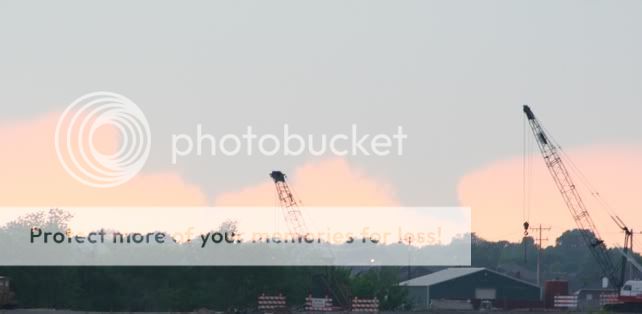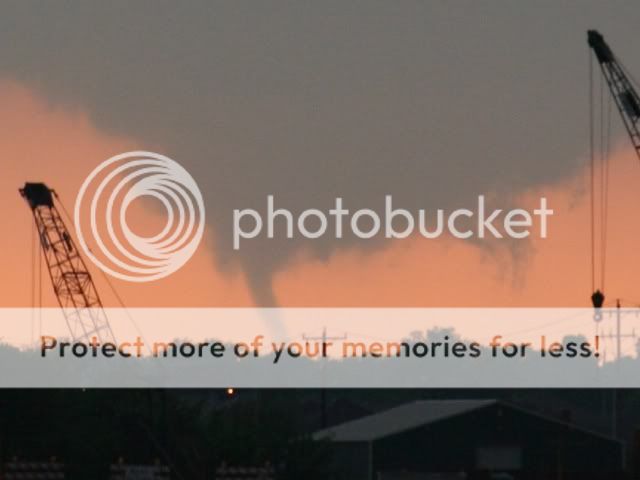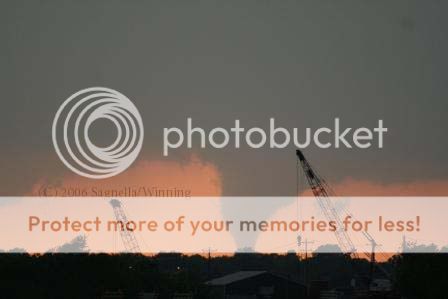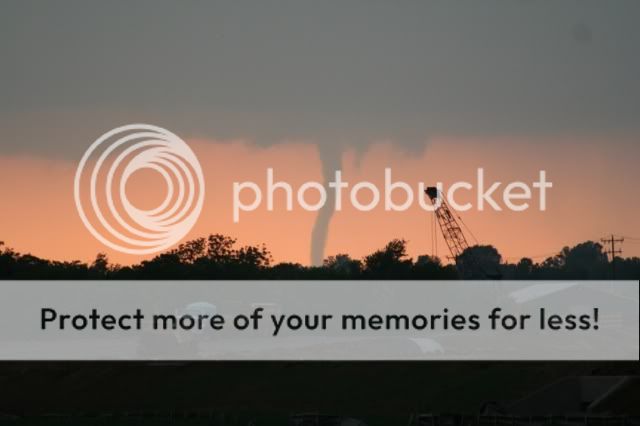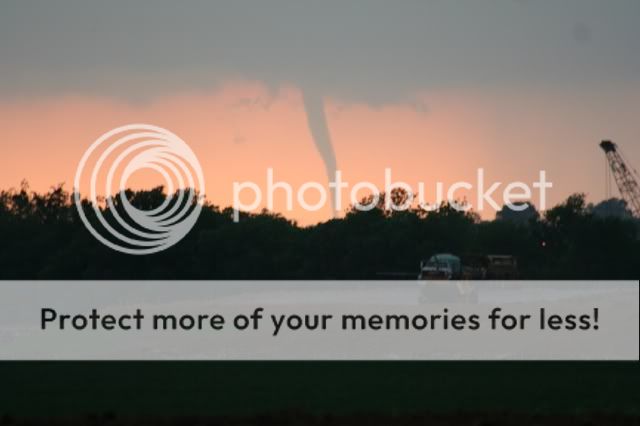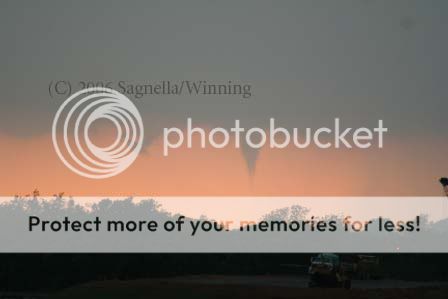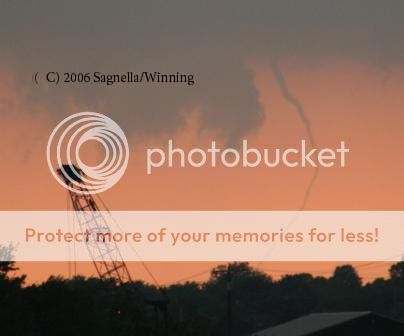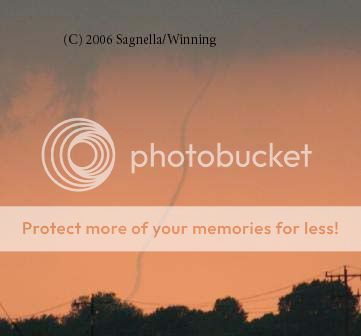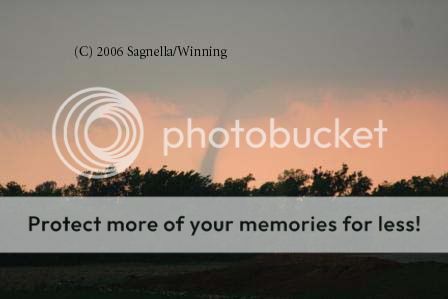Aaron Kennedy
EF5

The super-de-duper short version: Went "full circle" to snag the El Reno, OK tornadoes. Pictures at:
http://www.convectionconnection.com/CHASE-042406/
The long version:
I had high hopes for 4/24 before going out... primarily because of decent BL moisture. While it may have been more prudent to prepare for my thesis defense which was successfully completed today, there was no possible way I could resist a backyard chase. Besides... I wanted to visually document a few more descending reflectivity cores ; )
In support of PHOTEX ( http://hal9000.metr.ou.edu/PHOTEX/ ), myself, Ben Baranowski, and Liz Stoppkotte left at approximately 1pm. I hoped to meet with my advisor who was awaiting the arrival of my other committee member from the airport around 2pm. Ideally, we would have met up in the field and worked on stereo videography of some supercells.
We initially targeted the outflow boundary in NC OK and headed west towards El Reno, then north to Enid. Along I-40, I passed my favorite billboard, the Buffalo burger sign. Little did I know I'd be getting a better view of this sign later in the evening. To make a long story short, the convection in NC OK looked like garbage from our stand point. Perhaps we benefited from not having detailed radar information. We didn't realize one of the storms had a decent mesocyclone. Serendipity at work! After a narrow brush with a ditch on a bad road option, we received word from our now caster that new convection was initiating along the dryline. Convinced our current storms weren't going to pan out, we raced south on I35 towards the Anadarko storm.
As we neared OKC, we decided to take the Kilpatrick turnpike along the NW side. While I am normally opposed to tolls, I can honestly say this choice was the best $2 I've ever spent chasing - it allowed us to intercept the soon to be El Reno supercell with only a few minutes of time to spare. As we were traveling towards I-40, the El Reno storm rapidly developed. The storm quickly acquired a large rain-free base and for the first time during the day, I felt like we may have been on a decent storm. Once we turned west onto I-40, the storm developed a ragged wall cloud. After a brief jaunt off the interstate, we settled near the overpass at Exit 132. This position offered a largely unobstructed viewpoint of the storm.
As the wall cloud became better defined, I dashed to setup the camcorder and acquire GPS/compass heading/pitch/roll data. As soon as this chore was finished, I pulled out the camera and started snagging stills.
http://ww2.convectionconnection.com:8080/C...mg_0018_std.jpg (0024Z)
As luck would have it, the storm quickly became tornadic. A slender needle of condensation snaked down towards the surface...
http://ww2.convectionconnection.com:8080/C...mg_0023_std.jpg (0026:00Z)
For the next 14 minutes, I went into photographer fury mode. I rapidly changed lenses between my wide angle and telephoto in an attempt to grab a wide variety of shots. The first (and cyclonically rotating) tornado rapidly evolved from the original needle into a narrow-cone shape:
http://ww2.convectionconnection.com:8080/C...mg_0032_std.jpg (0027:24)
http://ww2.convectionconnection.com:8080/C...mg_0033_std.jpg (0027:48)
http://ww2.convectionconnection.com:8080/C...mg_0035_std.jpg (0028:18)
and then into a vertical rope:
http://ww2.convectionconnection.com:8080/C...mg_0036_std.jpg (0029:16)
wide angle shot:
http://ww2.convectionconnection.com:8080/C...mg_0040_std.jpg (0030:03)
The tornado started to tilt slightly, and then became somewhat translucent. At this point, we could finally see some debris (dirt):
http://ww2.convectionconnection.com:8080/C...mg_0043_std.jpg (0031:12)
The condensation then disappeared except for a few small filaments. While I thought the tornado was ending, it actually persisted for a while longer with the condensation reappearing on occasion in the form of a slender rope.
http://ww2.convectionconnection.com:8080/C...mg_0048_std.jpg (0032:07)
http://ww2.convectionconnection.com:8080/C...mg_0050_std.jpg (0032:19)
Around this time, the crowd of gatherers (all non-chasers at our location) started hollering about a second tornado:
http://ww2.convectionconnection.com:8080/C...mg_0053_std.jpg (0033:26)
While we were too far to discriminate which way it was rotating, it did appear to be in the proper location for an anticyclonic tornado. I didn't make that connection till a friend mentioned it later that night.
This tornado took on a rather landspoutish look with a largely translucent trunk accompanied by a large plume of dust near the ground:
http://ww2.convectionconnection.com:8080/C...mg_0057_std.jpg (0035:01)
While I thought the original tornado had dissipated completely, it in fact had not!
http://ww2.convectionconnection.com:8080/C...mg_0059_std.jpg (0035:51)
Wide angle:
http://ww2.convectionconnection.com:8080/C...mg_0060_std.jpg (0036:32)
A few last shots of the anticyclonic tornado:
http://ww2.convectionconnection.com:8080/C...mg_0066_std.jpg (0038:07)
http://ww2.convectionconnection.com:8080/C...mg_0067_std.jpg (0039:01)
A few remaining shots taken within Yukon, OK of the clouds during sunset:
http://ww2.convectionconnection.com:8080/C...mg_0070_std.jpg
http://ww2.convectionconnection.com:8080/C...mg_0080_std.jpg
http://ww2.convectionconnection.com:8080/C...mg_0083_std.jpg
Last remarks: From our viewpoint, the RFD appeared rain free. I managed to obtain the level II data from KTLX, and the first tornado had neither a substantial appendage or DRC associated with it. So much for a quick addition to my thesis defense!
Aaron


